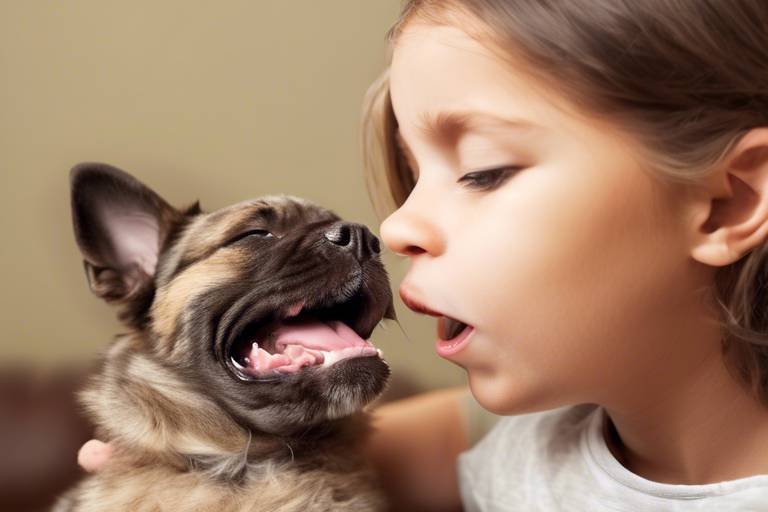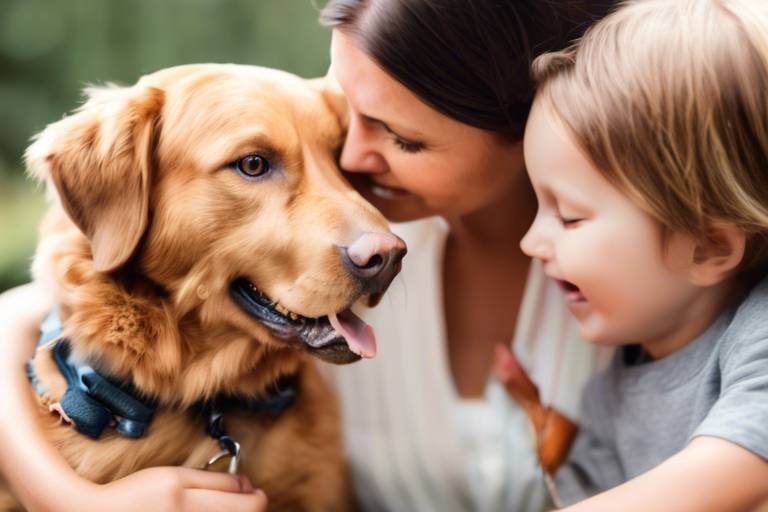How to Help Your Pet With Behavioral Issues at Home
Having a pet is one of life's greatest joys, but it can also come with its fair share of challenges. Behavioral issues in pets can be frustrating and stressful, not just for the animal but for the owner as well. The good news is that with the right understanding and techniques, you can make significant improvements in your pet's behavior. This article explores effective strategies and tips for addressing common behavioral issues in pets, ensuring a harmonious relationship between pets and their owners through understanding and training techniques.
Behavioral issues in pets can stem from various factors, including genetics, environment, and past experiences. Recognizing these underlying causes is crucial for effective intervention. For instance, a dog that barks excessively might be trying to communicate a need or expressing anxiety. Similarly, a cat that scratches furniture could be bored or stressed. By understanding the root of these behaviors, you can create a supportive environment that caters to your pet's needs.
Many pets exhibit behavioral problems such as aggression, anxiety, and excessive barking. Identifying these issues early can help in implementing appropriate solutions and improving your pet's overall well-being. For example, if you notice your dog growling at strangers, it may be a sign of fear or territorial behavior. Addressing these issues promptly not only enhances your pet's quality of life but also ensures a safer environment for everyone involved.
Anxiety can manifest in different ways, including hiding, excessive grooming, or destructive behavior. Understanding these signs helps owners take timely action to alleviate their pets' stress. For instance, if your dog starts chewing on furniture or your cat is constantly meowing, it could be a cry for help. Recognizing these symptoms early on can lead to effective strategies for easing their discomfort.
Separation anxiety is a common issue where pets become distressed when left alone. Recognizing its symptoms—such as whining, pacing, or even urinating in the house—can lead to effective strategies to help your pet feel more secure. Gradual desensitization, where you slowly increase the time you leave your pet alone, can be a useful technique. It’s a bit like teaching a child to swim; start in the shallow end before diving into the deep water.
Many pets react negatively to loud noises like thunderstorms or fireworks. Understanding their triggers can help in developing coping mechanisms to ease their discomfort. For example, creating a safe space for your pet with blankets and toys can provide them with a sense of security during these stressful times. Additionally, using white noise machines or calming music can help drown out the frightening sounds, much like how some people use earplugs to sleep better in noisy environments.
Aggression in pets can be concerning and potentially dangerous. Identifying the triggers—whether it’s a specific person, animal, or situation—and understanding the reasons behind aggressive behavior is essential for creating a safer environment. For instance, if your dog barks aggressively at other dogs, it could be a sign of fear or a need to assert dominance. Working with a professional trainer or behaviorist can provide tailored strategies to manage and reduce aggression effectively.
Implementing training techniques is vital for modifying undesirable behaviors. Consistency, patience, and positive reinforcement can lead to significant improvements in your pet's behavior over time. Think of training as building a bridge between you and your pet—each session strengthens that connection and fosters mutual understanding.
Using positive reinforcement, such as treats or praise, encourages desired behaviors. This technique builds trust and strengthens the bond between you and your pet while promoting learning. For example, if your dog sits on command, rewarding them with a treat not only reinforces that behavior but also makes them more likely to repeat it in the future. It’s a win-win situation!
Behavior modification strategies involve structured approaches to change unwanted behaviors. Implementing gradual exposure and desensitization can effectively help your pet adapt to challenging situations. For instance, if your dog is afraid of strangers, you might start by having friends visit while keeping a safe distance, gradually allowing closer interactions as your pet becomes more comfortable.
A supportive home environment plays a crucial role in addressing behavioral issues. Ensuring your pet feels safe and secure can significantly reduce stress and improve their behavior. Just like humans, pets thrive in stable and predictable environments.
Establishing consistent routines helps pets feel more secure and reduces anxiety. Regular feeding, exercise, and playtime create a predictable environment that can positively influence their behavior. Think of it as setting a schedule for a child; knowing what to expect helps them feel more at ease and confident.
Mental stimulation is essential for keeping pets engaged and preventing boredom-related behaviors. Interactive toys, puzzles, and training sessions can help maintain their mental well-being. Just like humans, pets need mental challenges to stay happy and healthy. Consider incorporating playtime that requires problem-solving, such as hiding treats in toys or teaching new tricks.
- What are the signs that my pet has a behavioral issue? Look for changes in behavior such as excessive barking, hiding, or aggression towards people or other animals.
- How can I help my pet with separation anxiety? Gradually increase the time you leave your pet alone and create a safe space for them with their favorite toys.
- Is positive reinforcement effective for all pets? Yes, most pets respond well to positive reinforcement, which builds trust and encourages good behavior.
- When should I seek professional help for my pet's behavior? If your pet's behavior poses a danger to themselves or others, or if you feel overwhelmed, it's best to consult a professional trainer or behaviorist.

Understanding Behavioral Issues
Behavioral issues in pets can be a source of frustration for both the animal and the owner. Understanding these issues is like peeling an onion; there are layers to uncover, and each layer reveals something important about your pet's emotional state. Various factors contribute to these behavioral problems, such as genetics, environment, and past experiences. Recognizing these underlying causes is crucial for effective intervention and creating a supportive environment for your furry friend.
For instance, a pet that has been adopted from a shelter may exhibit signs of fear or anxiety due to its previous experiences. On the other hand, a pet raised in a chaotic household might display aggression as a defense mechanism. Understanding the root cause of these behaviors allows pet owners to tailor their approach in a way that addresses the specific needs of their pets.
Some common behavioral issues include:
- Aggression: This can manifest as biting, growling, or even lunging at people or other animals.
- Anxiety: Pets may show signs of distress when left alone or during loud noises.
- Destructive behavior: Chewing furniture or digging holes can often be attributed to boredom or stress.
Recognizing these signs early on can be the difference between a minor issue and a major problem. It’s essential to observe your pet’s behavior closely and note any changes. Just like humans, pets communicate through their actions. A wagging tail doesn’t always mean happiness; it could also indicate excitement or nervousness.
Moreover, the environment plays a significant role in shaping a pet's behavior. For example, pets living in a stable, loving home tend to be more relaxed and well-adjusted than those in unpredictable or stressful environments. By creating a safe space, you can help alleviate many behavioral issues. This involves not just physical space but also emotional support, which can help your pet feel secure and loved.
In summary, understanding behavioral issues in pets requires a holistic approach. By recognizing the various factors that contribute to these behaviors, pet owners can provide the necessary support and training to help their pets thrive. Remember, the journey to a well-behaved pet is a partnership between you and your furry friend, built on trust, patience, and understanding.

Common Behavioral Problems
Just like humans, pets can exhibit a range of behavioral problems that can disrupt the harmony of your home. It’s crucial to identify these issues early on, as they can often escalate if left unaddressed. Some of the most common behavioral problems include aggression, anxiety, and excessive barking. Each of these behaviors can stem from a variety of underlying causes, and understanding these can help in implementing effective solutions.
For instance, aggression can manifest in various forms, such as growling, biting, or lunging at people or other animals. This behavior is often a response to fear, territoriality, or frustration. If you notice your pet exhibiting aggressive behavior, it’s essential to pinpoint the triggers. Is it a particular person, another animal, or perhaps a specific situation? Once you identify the cause, you can work on strategies to mitigate these reactions.
Anxiety is another common issue that can greatly affect your pet's quality of life. Pets suffering from anxiety may show signs such as pacing, whining, or even destructive behaviors like chewing furniture. This is often rooted in their environment or past experiences. For example, a rescue dog may have anxiety stemming from previous trauma. Understanding the context behind your pet’s anxiety is the first step towards helping them cope.
Excessive barking can be a source of frustration for pet owners and neighbors alike. Dogs may bark for various reasons, including boredom, fear, or a desire to get your attention. It’s important to observe when and why your pet barks. Are they barking at strangers, during play, or when they’re left alone? Addressing the underlying cause of barking can lead to a more peaceful home environment.
Here’s a quick overview of these common behavioral problems:
| Behavioral Problem | Possible Causes | Signs to Look For |
|---|---|---|
| Aggression | Fear, territoriality, frustration | Growling, biting, lunging |
| Anxiety | Environmental factors, past trauma | Pacing, whining, destructive behavior |
| Excessive Barking | Boredom, fear, attention-seeking | Barking at strangers, during play, when alone |
Recognizing these issues is the first step in creating a healthier relationship with your pet. By being attentive and proactive, you can address these behavioral problems effectively, leading to a happier and more balanced home for both you and your furry companion.
- What should I do if my pet is aggressive? - It's important to consult a professional trainer or behaviorist who can help you understand and address the triggers of aggression.
- How can I help my anxious pet? - Providing a safe space, establishing routines, and using calming products can significantly help reduce anxiety in pets.
- Is excessive barking a serious problem? - While barking is a natural form of communication for dogs, excessive barking can indicate underlying issues that need to be addressed.
Signs of Anxiety in Pets
When it comes to our beloved furry friends, understanding their emotional state is crucial. Just like humans, pets can experience anxiety, and recognizing the signs early can make a significant difference in their well-being. So, what should you look out for? Well, anxiety can manifest in various ways, and being aware of these signs can help you take timely action to alleviate your pet's stress.
One of the most common signs of anxiety is hiding. If your pet suddenly starts seeking out secluded areas in your home, it may be trying to escape from stressors. Similarly, excessive grooming can also indicate anxiety; if you notice your pet licking or biting at their fur more than usual, it could be a sign that they are feeling anxious. Destructive behavior, such as chewing on furniture or scratching at doors, is another red flag. These actions are often a cry for help, indicating that your pet is overwhelmed and needs your support.
Additionally, pets may exhibit physical symptoms of anxiety. For instance, you might notice them trembling, pacing, or having a decreased appetite. These behaviors can stem from various triggers, including changes in their environment, loud noises, or even separation from their owners. Understanding these signs is crucial, as it allows you to address the underlying issues and help your pet feel more secure.
To give you a clearer picture, here are some common signs of anxiety in pets:
- Hiding in corners or under furniture
- Excessive grooming leading to bald patches
- Destructive behavior such as chewing or scratching
- Trembling or shaking
- Pacing or restlessness
- Loss of appetite or changes in eating habits
Understanding these signs is the first step toward helping your pet cope with anxiety. Once you recognize these behaviors, you can begin to implement strategies to reduce their stress and promote a more peaceful home environment. Remember, your pet relies on you to be their advocate, so staying observant and proactive is key!
Q: How can I tell if my pet is anxious?
A: Look for signs such as hiding, excessive grooming, destructive behavior, trembling, pacing, or changes in eating habits. If your pet exhibits any of these behaviors, it may be experiencing anxiety.
Q: What should I do if I suspect my pet has anxiety?
A: Start by observing your pet's behavior closely and try to identify potential triggers. You may also want to consult with a veterinarian or a professional animal behaviorist for tailored advice and strategies.
Q: Are there specific breeds more prone to anxiety?
A: While any pet can experience anxiety, some breeds are more susceptible due to their temperament. Breeds like Border Collies, German Shepherds, and Labrador Retrievers may show higher levels of anxiety, especially if not properly socialized.
Q: Can anxiety in pets be treated?
A: Yes, anxiety can often be managed through a combination of behavioral training, environmental changes, and, in some cases, medication. It's essential to work closely with a veterinarian to find the best approach for your pet's specific needs.
Separation Anxiety
Separation anxiety is a common and distressing issue that many pet owners face. Imagine coming home after a long day to find your furry friend has turned your living room into a disaster zone. This behavior often stems from the overwhelming stress pets feel when left alone. It's as if they can't comprehend why their favorite human has vanished, leading to feelings of abandonment and fear. Recognizing the signs of separation anxiety is the first step toward helping your pet feel more secure.
Pets suffering from separation anxiety may exhibit a variety of behaviors. Some common signs include:
- Excessive barking or howling when left alone
- Destructive behaviors, such as chewing furniture or scratching doors
- House soiling, even if they are house-trained
- Pacing or restlessness
- Refusal to eat when left alone
The emotional turmoil that pets experience during these episodes is heartbreaking. They may feel as if they are trapped in a cycle of fear and loneliness, which can lead to a host of other behavioral issues. It's crucial to approach this problem with empathy and understanding. After all, your pet relies on you to provide a sense of safety and reassurance.
So, what can you do to help alleviate your pet's separation anxiety? Here are some effective strategies:
- Gradual Desensitization: Start by leaving your pet alone for short periods and gradually increase the duration. This helps them learn that being alone isn’t a permanent state.
- Comfort Items: Providing a favorite toy or blanket can offer a sense of comfort. The familiar scent can help soothe their anxiety.
- Consistent Routine: Establishing a predictable routine can make your pet feel more secure. Regular feeding and playtimes can create a sense of normalcy.
- Training Techniques: Teaching your pet commands like “stay” or “go to your bed” can help them feel more at ease when you leave the room.
It's essential to remember that every pet is unique, and what works for one may not work for another. Patience and persistence are key. If your pet's anxiety persists despite your efforts, consulting a veterinarian or a professional animal behaviorist can provide additional support and guidance. They can help identify any underlying health issues or recommend behavioral therapies that may be beneficial.
Ultimately, addressing separation anxiety is about building trust and security. By being proactive and attentive to your pet's needs, you can help them navigate their fears and enjoy a more relaxed and happy life at home.
Q1: How can I tell if my pet has separation anxiety?
A1: Look for signs such as excessive barking, destructive behavior, or changes in eating habits when you leave them alone.
Q2: Can separation anxiety be cured?
A2: While it may not be completely cured, it can often be managed with the right training techniques and environmental adjustments.
Q3: Should I punish my pet for destructive behavior caused by anxiety?
A3: No, punishment can exacerbate anxiety. Instead, focus on positive reinforcement to encourage desired behaviors.
Q4: How long does it take to see improvement in my pet's behavior?
A4: Improvement can vary based on the individual pet and the strategies used, but consistency and patience are crucial for success.
Noise Sensitivity
Noise sensitivity is a common issue that many pets face, and it can be quite distressing for both the animal and the owner. Imagine your beloved dog trembling in fear during a thunderstorm or your cat hiding under the bed when the fireworks start. These reactions stem from a genuine fear of loud sounds, which can trigger anxiety and lead to unwanted behaviors. Understanding how to help your furry friend cope with these situations is essential for their well-being.
Pets may react negatively to various loud noises, including thunderstorms, fireworks, vacuum cleaners, or even the sound of a doorbell. Each pet is unique, and their sensitivity can vary widely. For instance, while one dog might bark and pace, another may choose to hide away in a corner. This inconsistency can make it challenging for owners to pinpoint the best way to help their pets. However, recognizing the signs of noise sensitivity is the first step toward providing relief.
Here are some common signs that indicate your pet may be struggling with noise sensitivity:
- Trembling or Shaking: Many pets exhibit physical signs of fear, such as shaking or trembling.
- Hiding: A scared pet may seek refuge in a small, dark space.
- Excessive Barking or Meowing: Some animals vocalize more than usual when they are anxious.
- Destructive Behavior: In an attempt to escape their fear, pets might scratch furniture or chew on objects.
To help your pet cope with noise sensitivity, consider creating a safe space where they can retreat during stressful situations. This area should be quiet, comfortable, and filled with their favorite toys or blankets. Additionally, using calming techniques such as playing soft music or using white noise machines can help mask the frightening sounds from outside. Furthermore, desensitization training can also be effective. Gradually exposing your pet to the sounds they fear at a low volume and rewarding them for calm behavior can help them build confidence over time.
In some cases, consulting with a veterinarian or a professional animal behaviorist may be necessary. They can provide tailored advice and, if needed, suggest medications that can help alleviate anxiety. Remember, patience and understanding are key. It may take time for your pet to adjust, but with the right strategies in place, you can help them navigate their fears and live a more relaxed life.
Addressing Aggression
Aggression in pets can be one of the most alarming behaviors for any pet owner. It’s not just about barking or growling; aggression can manifest in various forms, such as biting, lunging, or even showing teeth. Understanding the underlying causes of this behavior is crucial for both the safety of your pet and those around them. Often, aggression stems from fear, territoriality, or even pain. Just like humans, pets have their own ways of expressing discomfort or anxiety, and it’s our job to decode those signals.
To effectively address aggression, the first step is to identify the triggers. Observe your pet closely and note the situations that lead to aggressive behavior. Is it when they are approached while eating? Or perhaps when they see another dog on a walk? By pinpointing these triggers, you can develop a strategy to manage and modify your pet's behavior. For instance, if your dog is aggressive towards strangers, it may help to create a safe space where they can retreat when feeling overwhelmed.
Moreover, addressing aggression requires a careful approach. Here are some strategies that can help:
- Consult a Professional: Sometimes, the best course of action is to consult with a veterinarian or a certified animal behaviorist. They can provide insights and tailored strategies to help manage your pet's aggression.
- Desensitization: Gradually exposing your pet to their triggers in a controlled manner can help them build tolerance. For example, if your dog is aggressive towards other dogs, start by introducing them to calm, friendly dogs at a distance.
- Positive Reinforcement: Rewarding your pet for calm behavior can reinforce positive actions. Use treats or praise when they remain calm in situations that would typically trigger aggression.
In addition to these methods, it's essential to maintain a calm demeanor yourself. Pets are incredibly perceptive and can pick up on their owner's anxiety or frustration. If you remain calm and assertive, it helps reassure your pet and create a more stable environment. Remember, patience is key. Changing aggressive behavior won’t happen overnight; it requires consistent effort and understanding.
Finally, never hesitate to seek help if the aggression seems severe or unmanageable. There’s no shame in reaching out for assistance, whether it’s from a professional trainer or a support group. Your pet’s safety and the safety of those around them should always come first. By taking proactive steps, you can help your pet overcome their aggressive tendencies and foster a more positive relationship.
Q: Can all aggressive behaviors be corrected?
A: While many aggressive behaviors can be managed or modified with proper training and techniques, some may require professional intervention. It's important to assess each situation individually.
Q: How long does it take to see improvement in aggressive behavior?
A: The timeline for improvement can vary greatly depending on the pet and the severity of the aggression. Consistent training and patience are essential for long-term success.
Q: Should I punish my pet for aggressive behavior?
A: Punishment is generally not recommended, as it can exacerbate fear and anxiety, leading to more aggression. Instead, focus on positive reinforcement and redirecting their behavior.

Training Techniques for Improvement
When it comes to addressing behavioral issues in pets, training techniques are your best allies. Think of training as the foundation of a harmonious relationship between you and your furry friend. Just like we learn through experience, pets thrive on understanding what is expected of them. By implementing effective training techniques, you can help your pet learn desirable behaviors while reducing unwanted ones, leading to a happier household for both of you.
One of the most effective methods is positive reinforcement. This technique involves rewarding your pet for good behavior, which can include treats, praise, or even playtime. Imagine your pet as a student in a classroom; when they answer correctly, they receive a gold star. This approach not only encourages them to repeat the behavior but also strengthens the bond between you and your pet. For instance, if your dog sits on command and you reward him with a treat, he learns that sitting equals something good. Over time, this can lead to a more obedient and well-mannered pet.
However, it's essential to be consistent with your rewards. If you reward your pet one day for sitting but ignore them the next, it can lead to confusion. Establishing a routine where your pet knows when and how they will be rewarded is crucial. Consistency helps in solidifying the learning process, just like a well-rehearsed dance routine where every step is predictable.
Another effective approach is behavior modification strategies. This involves a structured method to change unwanted behaviors. For example, if your dog barks excessively when the doorbell rings, you can gradually expose him to the sound of the doorbell while rewarding him for remaining calm. This process, known as desensitization, allows your pet to associate the doorbell with positive experiences rather than stress. Over time, they will learn that the doorbell doesn't mean chaos; instead, it can be a signal for a treat or a fun game!
In addition to these techniques, creating a supportive environment is vital for successful training. Pets, much like us, need a sense of security to thrive. Establishing a routine can significantly help your pet feel more at ease. Regular feeding, exercise, and playtime create a predictable environment that influences their behavior positively. Imagine how you feel when your day is structured; it brings a sense of calm and control, doesn’t it? Pets feel the same way!
Moreover, providing mental stimulation is crucial for keeping your pet engaged. Boredom can lead to a host of behavioral problems, so it’s essential to keep their minds active. Interactive toys, puzzles, and even training sessions can serve as excellent outlets for your pet’s energy. Think of their mind as a muscle; the more you exercise it, the stronger it becomes. You wouldn’t want to neglect your physical health, so why would you neglect your pet’s mental well-being?
In conclusion, employing a combination of positive reinforcement, behavior modification strategies, and creating a supportive environment can lead to significant improvements in your pet's behavior. Remember, patience is key. Just like learning a new skill takes time, so does training your pet. With love, consistency, and understanding, you'll see your furry friend flourish!
- How long does it take to train a pet? Training times can vary based on the pet's age, breed, and the complexity of the behavior being addressed. Generally, with consistent practice, you can see improvements in a few weeks.
- Can I train my pet myself, or should I hire a professional? While many pet owners successfully train their pets at home, seeking professional help can be beneficial, especially for more challenging behaviors.
- What if my pet is not responding to training? If your pet is struggling, it may be helpful to reassess your training methods or consult a veterinarian or a professional trainer for tailored advice.
Positive Reinforcement Methods
When it comes to training our furry companions, positive reinforcement is like the golden rule of pet behavior. Imagine this: instead of punishing your pet for doing something wrong, you reward them for doing something right. This approach not only encourages good behavior but also strengthens the bond between you and your beloved pet. Who wouldn’t want a happy, well-behaved buddy by their side?
So, how does positive reinforcement work? It’s actually quite simple! Whenever your pet performs a desired behavior, such as sitting on command or not barking at the mailman, you immediately reward them with something they love. This could be a tasty treat, a favorite toy, or even a few minutes of playtime. The key is to make the reward immediate so that your pet associates the action with the positive outcome. Think of it as a high-five for your pet's brain!
Here are some effective positive reinforcement methods you can start using today:
- Treats: Small, healthy treats can work wonders. Just make sure they’re something your pet loves!
- Praise: Verbal affirmations like “Good boy!” or “You’re such a smart girl!” can boost your pet’s confidence.
- Playtime: Some pets are motivated by play. A quick game of fetch or tug-of-war can serve as a great reward.
Now, you might be wondering, “How do I know when to reward my pet?” Timing is everything! For example, if you’re teaching your dog to sit, as soon as they lower their bottom to the ground, that’s your cue to deliver the treat. This immediate reward helps them understand exactly what behavior you’re encouraging. It’s almost like giving them a little light bulb moment!
Another important aspect of positive reinforcement is consistency. If you reward your pet for sitting today but ignore it tomorrow, they’ll get confused. Imagine trying to learn a new dance move, but your instructor keeps changing the steps! Consistency in your rewards helps your pet learn and feel secure in their training.
As you embark on this training journey, remember that patience is key. Some pets may take longer to learn than others, and that’s perfectly okay! Celebrate the small victories along the way. If your pet sits for just a second, reward them! This encourages them to try again. Over time, you’ll see those tiny steps blossom into significant progress.
Lastly, don’t forget to mix things up! Pets can get bored with the same old routine. Introduce new commands, tricks, or even different types of rewards to keep their interest piqued. Just like us, pets thrive on variety and excitement. So, whether it’s teaching them to roll over or giving them a new puzzle toy, keep the fun alive!
In conclusion, positive reinforcement is not just a training method; it’s a way to build a trusting relationship with your pet. By focusing on the good behaviors and rewarding them, you’ll create a happy, well-adjusted companion who loves to learn and grow with you. So grab those treats, get ready to praise, and watch your pet shine!
Q: How long should I train my pet each day?
A: Short, frequent training sessions of about 5-10 minutes are usually most effective. This keeps your pet engaged without overwhelming them.
Q: What if my pet doesn't respond to treats?
A: Every pet is different! If treats aren’t working, try using praise, toys, or even affection as rewards. Find what motivates your pet the most!
Q: Can I use positive reinforcement for bad behavior?
A: Absolutely! You can redirect bad behavior by rewarding your pet when they choose a desirable action instead. For example, if your dog barks at the door, reward them for sitting quietly instead.
Q: Is positive reinforcement suitable for all pets?
A: Yes! Positive reinforcement can be applied to dogs, cats, and even small animals. It’s a universal method that promotes a healthy relationship between pets and their owners.
Behavior Modification Strategies
When it comes to addressing behavioral issues in pets, serve as a beacon of hope. These structured approaches can significantly change unwanted behaviors over time, but they require a blend of patience, consistency, and understanding. Imagine trying to teach a child a new skill; it’s not just about telling them what to do but guiding them through the process, step by step. The same principle applies to our furry friends.
One effective method within behavior modification is gradual exposure. This technique involves slowly introducing your pet to the situations or stimuli that trigger their unwanted behaviors. For example, if your dog is fearful of other dogs, you might start by allowing them to observe other dogs from a distance where they feel safe. As they become more comfortable, you can gradually decrease the distance, allowing for positive associations to form. This process helps to build their confidence and reduce anxiety.
Another crucial element is desensitization. This strategy works hand-in-hand with gradual exposure. It involves exposing your pet to the anxiety-inducing stimulus at a low intensity and rewarding them for remaining calm. Over time, you can increase the intensity of the stimulus while continuing to reward positive behavior. Think of it as turning down the volume on a loud radio; as your pet gets used to the sound, you gradually increase it until it’s at a level they can handle without becoming distressed.
To effectively implement these strategies, you might consider using a
| Date | Stimulus | Distance/Intensity | Response | Reward Given |
|---|---|---|---|---|
| 01/01/2023 | Other Dogs | 50 ft | Calm | Treat |
| 01/02/2023 | Other Dogs | 30 ft | Excited | No Treat |
| 01/03/2023 | Other Dogs | 40 ft | Calm | Treat |
Finally, it’s essential to remember that each pet is unique, and what works for one might not work for another. Be flexible and willing to adapt your strategies based on your pet's responses. You might even find that combining various techniques yields the best results. The journey of behavior modification is not always straightforward, but with love, patience, and the right strategies, you can help your pet thrive in a supportive and understanding environment.
- How long does it take to see results from behavior modification? - The timeline varies depending on the pet and the behavior being addressed. Some pets may show improvement within weeks, while others may take months.
- Can I use behavior modification techniques on my own? - Yes, many pet owners can successfully implement these strategies at home. However, consulting a professional trainer or behaviorist can provide additional support.
- What should I do if my pet's behavior worsens during training? - If you notice an increase in undesirable behavior, it may be a sign that the exposure is too intense. Reassess your approach and consider taking a step back.

Creating a Supportive Environment
Creating a supportive environment for your pet is like building a cozy nest where they can thrive. Just as we humans need a safe space to unwind and feel secure, our furry friends require the same comfort. When you think about it, a happy pet is often a well-adjusted one, and a supportive home plays a crucial role in achieving that. But what does it really mean to create such an environment? Let's dive into the essentials!
First and foremost, establishing consistent routines can work wonders for your pet's sense of security. Imagine waking up every day to the same schedule; it’s comforting, right? For pets, knowing when to expect meals, walks, and playtime helps them feel grounded. This predictability can significantly reduce anxiety levels, which leads to a more relaxed and happy companion. Whether it's a morning walk or an evening play session, consistency is key!
Moreover, providing mental stimulation is essential in keeping your pet engaged and preventing boredom-related behaviors. Boredom can lead to destructive habits, much like how a restless child might act out when they have nothing to do. To keep your pet mentally stimulated, consider incorporating interactive toys, puzzles, or training sessions into their daily routine. These activities not only challenge their minds but also strengthen the bond you share. After all, a tired pet is often a well-behaved one!
Another critical aspect of creating a supportive environment is ensuring that your pet has a safe space to retreat to when they feel overwhelmed. This could be a cozy bed in a quiet corner or a designated area where they can relax without disturbances. Think of it as their personal sanctuary—a place where they can feel secure and recharge. Providing this safe haven can help alleviate stress and anxiety, especially during noisy events like thunderstorms or fireworks.
Additionally, consider the importance of socialization. Just like humans, pets thrive on social interactions. Exposing your pet to various environments, people, and other animals can help them become more adaptable and confident. This exposure not only enriches their lives but also helps alleviate behavioral issues stemming from fear or anxiety. Just remember to introduce new experiences gradually, ensuring that your pet feels comfortable and safe throughout the process.
Lastly, never underestimate the power of love and attention. Pets are incredibly intuitive and can sense when they are being cared for. Regularly spending quality time with your furry friend can do wonders for their emotional well-being. Whether it’s a cuddle session on the couch or a playful romp in the yard, these moments of affection reinforce the bond you share and contribute to a happier, healthier pet.
- What are some signs that my pet is feeling anxious? Common signs of anxiety include excessive barking, hiding, destructive behavior, and changes in eating habits.
- How can I tell if my pet feels safe in their environment? If your pet frequently relaxes, plays, and engages with you and their surroundings, they likely feel secure.
- Are there specific toys that help with mental stimulation? Yes! Puzzle toys, treat-dispensing toys, and interactive games can keep your pet mentally engaged.
- How long does it take for a pet to adjust to a new routine? Every pet is different, but generally, it can take a few weeks for them to fully adapt to a new routine.
Establishing Routines
Establishing consistent routines for your pet is like creating a roadmap for their daily life. Just as humans thrive on structure, our furry friends feel more secure and relaxed when they know what to expect. Imagine waking up every day to a whirlwind of uncertainty—wouldn't that create anxiety? For pets, a predictable schedule can be a game-changer. It helps them understand when it's time to eat, play, and rest, which can significantly reduce feelings of stress and anxiety.
When you establish a routine, consider incorporating various activities that cater to your pet's physical and mental needs. For instance, a typical day might include:
- Morning Walks: Starting the day with a refreshing walk not only provides exercise but also stimulates your pet's senses.
- Feeding Times: Consistent feeding schedules can help regulate their digestion and prevent overeating.
- Play Sessions: Regular playtime fosters bonding and keeps your pet mentally sharp.
- Quiet Time: Just like us, pets need downtime to recharge. Establishing a calm environment during certain hours can help your pet relax.
Moreover, incorporating training sessions into your daily routine can be incredibly beneficial. Not only does this provide mental stimulation, but it also reinforces good behavior. For example, you could dedicate 10-15 minutes each day to practice commands or tricks. Over time, this consistency builds a stronger bond between you and your pet, as they learn to trust you as their leader.
To make it easier, consider creating a simple schedule that outlines your pet’s daily activities. A table like the one below can serve as a visual guide:
| Time | Activity |
|---|---|
| 7:00 AM | Morning Walk |
| 8:00 AM | Breakfast |
| 9:00 AM | Playtime |
| 12:00 PM | Afternoon Walk |
| 1:00 PM | Training Session |
| 5:00 PM | Dinner |
| 8:00 PM | Quiet Time |
Remember, flexibility is key. While routines are essential, life can be unpredictable. If you need to adjust your schedule occasionally, that's perfectly okay! The goal is to create a general structure that your pet can rely on, allowing them to feel safe and loved in their environment. By establishing and maintaining routines, you’re not just enhancing your pet's behavior; you’re enriching their overall quality of life.
Q: How long does it take for my pet to adjust to a new routine?
A: It varies by pet, but typically, it can take a few days to a few weeks for them to adapt fully. Consistency is crucial!
Q: What if my pet resists the new routine?
A: Start slowly and be patient. Gradually introduce new activities and give your pet time to adjust. Positive reinforcement can also help.
Q: Can I change the routine once it's established?
A: Yes! While routines are important, flexibility is essential. Feel free to adjust as needed, but try to maintain some consistency.
Q: How do I know if my pet is benefiting from a routine?
A: Look for signs of reduced anxiety, improved behavior, and overall happiness. A relaxed pet is often a well-adjusted pet!
Providing Mental Stimulation
Mental stimulation is a crucial aspect of your pet's well-being that often goes overlooked. Just like humans, pets require activities that challenge their minds and keep them engaged. Without adequate mental stimulation, pets can become bored, leading to destructive behaviors such as chewing furniture or excessive barking. Think of it this way: if you were stuck in a room with nothing to do, wouldn't you get restless? Your furry friends feel the same way!
To ensure your pet remains mentally sharp and content, consider incorporating a variety of stimulating activities into their daily routine. Here are some effective methods to provide mental stimulation:
- Interactive Toys: Invest in toys that require your pet to solve puzzles or manipulate objects to receive a reward, such as treats. These toys not only keep them busy but also enhance their problem-solving skills.
- Training Sessions: Regularly engaging your pet in training sessions can be both mentally stimulating and beneficial for their behavior. Teaching new tricks or commands not only reinforces good behavior but also strengthens your bond.
- Hide and Seek: This playful game can be a fantastic way to engage your pet's mind. Hide treats around the house and encourage your pet to find them. This taps into their natural scavenging instincts and provides a fun challenge.
- Obstacle Courses: Create a mini obstacle course in your home or backyard using household items. Guide your pet through the course, which will require them to think and navigate their way through the challenges.
Moreover, consider rotating toys regularly to keep things fresh and exciting. Just like we enjoy variety in our activities, pets can benefit from new experiences too. A simple change, like introducing a new toy or varying the training routine, can reignite their interest and enthusiasm.
Another fantastic way to stimulate your pet's mind is through socialization. Arrange playdates with other pets or take them to the dog park. Interacting with other animals can provide mental challenges and help your pet develop essential social skills.
In conclusion, providing mental stimulation is not just about keeping your pet entertained; it's about ensuring their overall health and happiness. A mentally stimulated pet is a happy pet, and that happiness translates into a stronger bond between you and your furry companion. So, get creative and make mental challenges a regular part of your pet's life!
Q1: How can I tell if my pet is bored?
A1: Signs of boredom in pets may include destructive behavior, excessive barking or meowing, or a lack of interest in their usual activities. If you notice these signs, it might be time to introduce new mental stimulation activities.
Q2: How often should I engage my pet in mental stimulation activities?
A2: Aim for at least 15-30 minutes of mental stimulation each day, but you can adjust this based on your pet's energy levels and preferences. Regular engagement is key!
Q3: Are there specific toys that are better for mental stimulation?
A3: Yes! Look for toys that are designed for brain games, such as puzzle feeders, treat-dispensing toys, or interactive games that require your pet to think and problem-solve.
Frequently Asked Questions
- What are some common signs of anxiety in pets?
Pets may show signs of anxiety through behaviors like hiding, excessive grooming, or even destructive actions. If you notice your furry friend acting unusually, it’s essential to pay attention to these signals.
- How can I help my pet with separation anxiety?
To help a pet with separation anxiety, try gradually getting them used to being alone for short periods. You can also create a safe space for them with their favorite toys and blankets, and consider using calming products or techniques.
- What should I do if my pet is aggressive?
Identifying triggers for your pet's aggression is crucial. Once you know what causes the behavior, work on desensitizing your pet to those triggers and consider seeking professional help if needed.
- How does positive reinforcement work in training pets?
Positive reinforcement involves rewarding your pet for good behavior with treats, praise, or playtime. This method helps build trust and encourages your pet to repeat the desired behaviors, making training more effective.
- Why is mental stimulation important for pets?
Mental stimulation keeps pets engaged and helps prevent boredom-related behaviors. Activities like interactive toys, puzzles, and training sessions provide valuable challenges that can enhance your pet's well-being.
- How can I create a supportive environment for my pet?
Establishing a routine for feeding, exercise, and playtime can create a predictable environment that helps your pet feel secure. Additionally, providing a quiet space for them to retreat to can significantly reduce stress.
- What are some effective behavior modification strategies?
Behavior modification strategies often include gradual exposure to the source of anxiety or fear and desensitization techniques. Working with a professional trainer can also provide tailored approaches to your pet's specific issues.



















